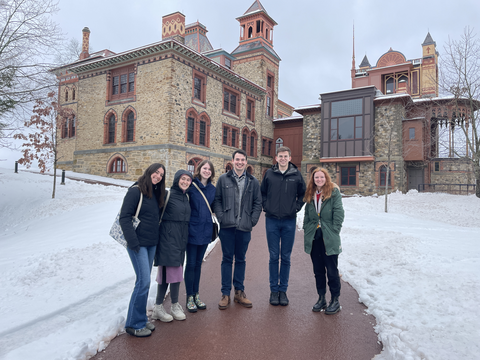American Classicisms in the Hudson Valley
Up on a hill just above the Hudson River stands a rather strange house. Though the house looks over the Rip Van Winkle Bridge and the town of Catskill, New York, its rough stone walls would seem right at home in a Tuscan villa or an English castle. And while the delicate wooden columns of the portico at the back of the house suggest a western Mediterranean influence, the painted façade of the tower at the heart of the building evokes Persian architecture. Atop this central tower, adorning its four corners, sit four metal teapots that (literally) top off the building’s eclectic style.
This peculiar house is Olana, the home of Frederic Edwin Church, one of the most famous members of the Hudson River School. Born in 1826 in Hartford, Connecticut, Church is best known today for his colossal landscapes, like Niagara and Heart of the Andes. Earlier this spring, the American Classicisms working group toured the Olana State Historic Site. American Classicisms, an interdisciplinary working group of Yale graduate students and faculty funded by the Whitney Humanities Center, was founded to investigate the role of Greco-Roman antiquity in the seventeenth and eighteenth centuries, in what would become the United States.
Our interest in Olana was first sparked by Church’s colossal 1871 painting The Parthenon, which we learned he painted while on a lengthy trip to Europe and the Middle East with his wife, Isabel. This trip seemed to have fueled his imagination with what became a lifelong passion for the classical world. This trip also inspired the idiosyncratic design of the house, both inside and out.
Our tour guide Don explained that Frederic and Isabel Church developed the house and estate over the course of many years. Before construction began on the house that we visited, they lived in a far humbler dwelling (now demolished, along with Church’s original studio), referred to as simply “The Farm.” At some point after the main house was built, the two began to refer to it in letters as “Olana.” Although Don suggested that the real origin of the name remains a mystery, it is probably a reference to a location mentioned by the Ancient Greek geographer Strabo. A visit to the library tucked in the middle of Olana allowed us to view Church’s collection of classical texts. We found guidebooks to ancient sites in the Mediterranean and several copies of Greek and Latin texts. (I didn’t come across Strabo, but I did find Pliny’s Natural History.)
Over the last two years, American Classicisms has expanded our scope to include the presence of classical antiquity both in the post-revolutionary US and throughout the Americas up until the present day. It was fitting, perhaps, that our first field trip since the pandemic should be to a site that expanded the “Classicisms” part of our remit—to a site where Greco-Roman antiquity was just one of many classical cultures that inspired a major figure in American art throughout his life. Through the Middle Eastern decorative motifs on the central tower, engravings of a winged lion—the ancient Mesopotamian lammasu—on each of the pillars in front of the main staircase, and the piles of artifacts collected on Church’s later trips to Mexico, the Olana State Historic Site emphasizes that the Greeks and Romans were but one source of Church’s inspiration.
As a group of scholars who typically meet on campus, where we read about and discuss the presence of antiquity in the lives of figures from American history, it was refreshing to go on an excursion where we could see, walk around, and experience artifacts in context. At our next event, “Why American Classicisms? A Roundtable Discussion,” we’ll continue to reflect on what it means to expand the temporal, spatial, and methodological scope of American Classicisms. You can join the conversation on Thursday, April 27 at 4 p.m. in Phelps Hall, room 401.
 Thomas Munro is a fourth-year Ph.D. candidate in the Classics department, writing his dissertation on the factors that influenced the reception of classical antiquity in his native Britain after World War II. In addition to running the American Classicisms working group, he is the co-convener of Yale Classics’ Departmental Colloquium 2022–23: Negotiating Empire.
Thomas Munro is a fourth-year Ph.D. candidate in the Classics department, writing his dissertation on the factors that influenced the reception of classical antiquity in his native Britain after World War II. In addition to running the American Classicisms working group, he is the co-convener of Yale Classics’ Departmental Colloquium 2022–23: Negotiating Empire.

